Jewelry
boxes and cabinets

Request
current list of available Jewelry boxes.
writing-boxes
jewelry-boxes
tea caddies
sewing-boxes
contents
| |
\
Antique satinwood box
decorated with facet cut steel decoration Circa 1790.
Please click on images to enlarge | slide show | thumbnail index |
Reference: JB174
Description: Antique satinwood box studded with faceted cut
steel decoration, having liftout trays secret compartment, and still
retaining its original Tyrian (royal) purple velvet interior linings.
Origin: France (Palais Royal)
or England.
Circa: 1790
Materials: Satinwood,
faceted steel, rosewood, purple velvet leather and silk.
Size: 34.6cm wide by 23.1cm by 14cm: 13.6 inches wide by
9.1 inches
by 5.5 inches.
Condition: Good
over all especially considering age, working lock and key. There is
some wear to the rare purple velvet and the leather linings. there
are marks on the side indicating that the box perhaps had side
handles. The holes have been filled with satinwood which matches the
original.
|
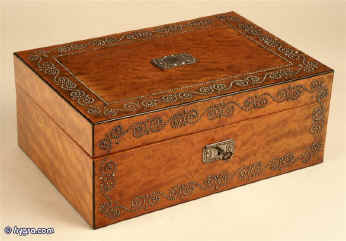
This is a rare sophisticated box.
|
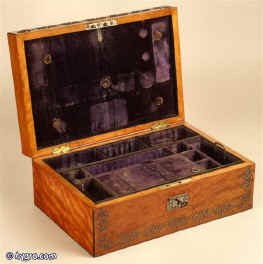
|
Inside the box has a liftout
tray lined with the original Tyrian purple velvet. The lid has a fold
down flap containing a document wallet and also a free standing
satinwood framed mirror (see below)
|
Please click on images to enlarge | slide show | thumbnail index |
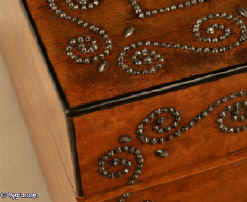
|
The use of steel as a medium of applied art was
developed in Tula , in Russia , which already had a long tradition of
metalworking, mainly for armory. Under the auspices of Catherine II,
steel became a medium for fashioning both domestic and personal
ornaments. In sewing it was used both for chatelaines and tools. The
diamond faceted, jewel like steel pins were adopted by French workers
for the fine Palais Royal boxes and to a lesser extent for other boxes.
This form of decoration was sparingly adopted in
England , although, ironically, the steel heads were exported to France
from the Northern English towns of Wolverhampton and Birmingham and from
Woodstock in Oxfordshire. Perhaps it was the expressed realization of
how much an old nail was worth once it was converted into a cut steel
ornament, which put off the English; they preferred to sell their old
nails to the French.
|
The Palais Royal area of Paris were justifiably
exchanged as precious gifts at the end of the 18th and into beginning of
the 19th century. During the short period of peace in the early 19th
century and after the permanent peace of 1815, the English aristocracy
rushed to France and indulged in quality shopping. The Palais Royal
shops were a great attraction to the visitors. These establishments
occupied a wing built in the 18th century by Louis Philippe d'Orléans,
when he inherited the palace and gave it the name Palais Royal.
Originally the palace was built for Richelieu and it was called Palais
Cardinal.
See: Antique
Boxes, Tea Caddies, and Society, 1700--1880
Antigone Clarke & Joseph O'Kelly, ISBN: 0764316885
|
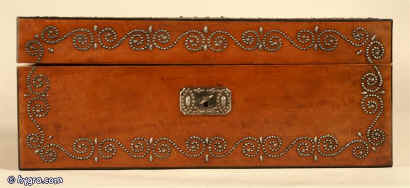
|
Please click on images to enlarge | slide show | thumbnail index |
Please click on images to enlarge | slide show | thumbnail index |
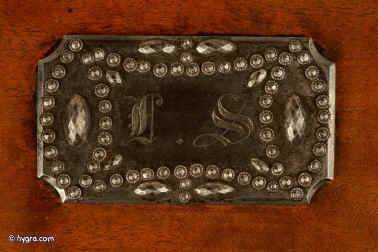
|
The
diamond faceted, jewel like steel pins were adopted by French workers
for the fine Palais Royal boxes and to a lesser extent for other boxes.
|
Please click on images to enlarge | slide show | thumbnail index |
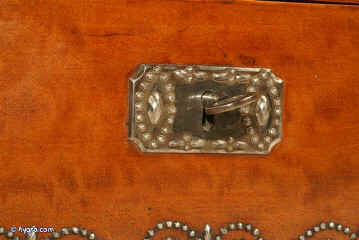
|
Detail of the elaborate cut
steel escutcheon.
|
Underneath the lift out tray is lined
with blue leather. There is a smaller lift out tray which is lined with
the original cream silk and has divisions for holding rings and earrings.
|
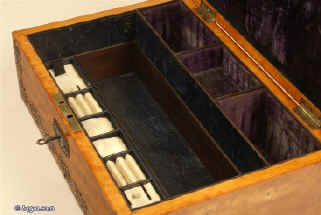
|
secret compartment
There is a secret movable panel of rosewood here shown
closed.
This is unusual in this type of box.
|

|
Please click on images to enlarge | slide show | thumbnail index |
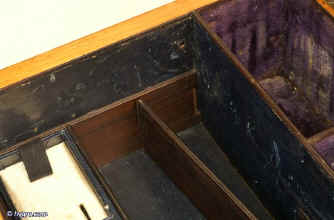
|
and here open. It is released by pressing the side.
|
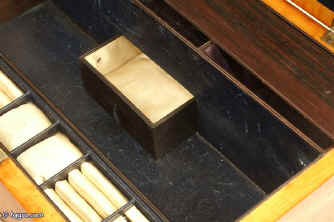
|
There is a secret silk lined rosewood drawer which is revealed when
the panel is removed.
|
Please click on images to enlarge | slide show | thumbnail index |
Detail of the lower liftout tray. The silk is in remarkably
good condition for 200 years!
|
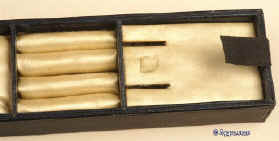
|
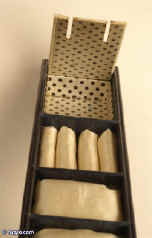
|
The underside is lined with a silver and blue dot paper which
is original and has almost no wear.
|
Please click on images to enlarge
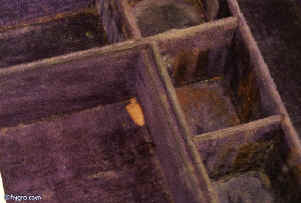
|
The upper tray is lined with
Tyrian purple velvet. This has some staining and wear marks. However
because the historical importance of this color I would not recommend
replacement. The look is of sophisticated quality decadence.
From Wikipedia we learn:
"Tyrian purple (Greek:
πορφύρα,
porphura), also known as royal purple or imperial purple,
is a purple-red dye
made by the ancient Canaanites/Phoenicians
in the city of Tyre,
from a mucus-secretion of the hypobranchial gland of a marine snail
known as Murex
brandaris or the Spiny dye-murex.
|
Please click on images to enlarge | slide show | thumbnail index |
The fast, non-fading dye was an item of luxury trade, prized by Romans,
who used it to colour ceremonial robes. Pliny
the Elder described the dyeing process of two purples in his Natural
History[2]:
"'... the Tyrian hue ... is considered of the best quality when
it has exactly the colour of clotted blood, and is of a blackish hue to
the sight, but of a shining appearance when held up to the light; hence
it is that we find Homer speaking of "purple blood'."
|
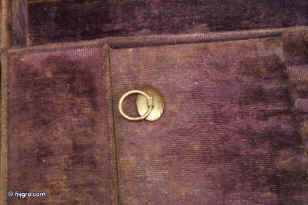
|
There is a satinwood framed self standing t mirror which is
stored behind the document wallet in the lid when not in use.
|
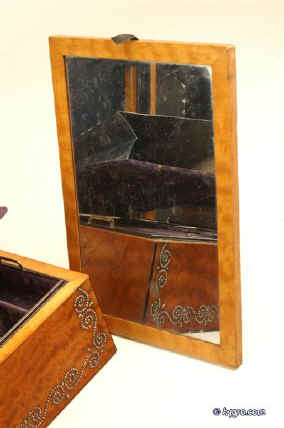
|
Please click on images to enlarge | slide show | thumbnail index |
.JPG)
|
Detail of the Document wallet which is made of subtly embossed
blue leather.
|
Please click on images to enlarge | slide show | thumbnail index |
All text and images and linked images are ©
1999-2007 Antigone Clarke and Joseph O'Kelly. If you require any further
information on permitted use, or a licence to republish any material, email us
at copyright@hygra.com
|
